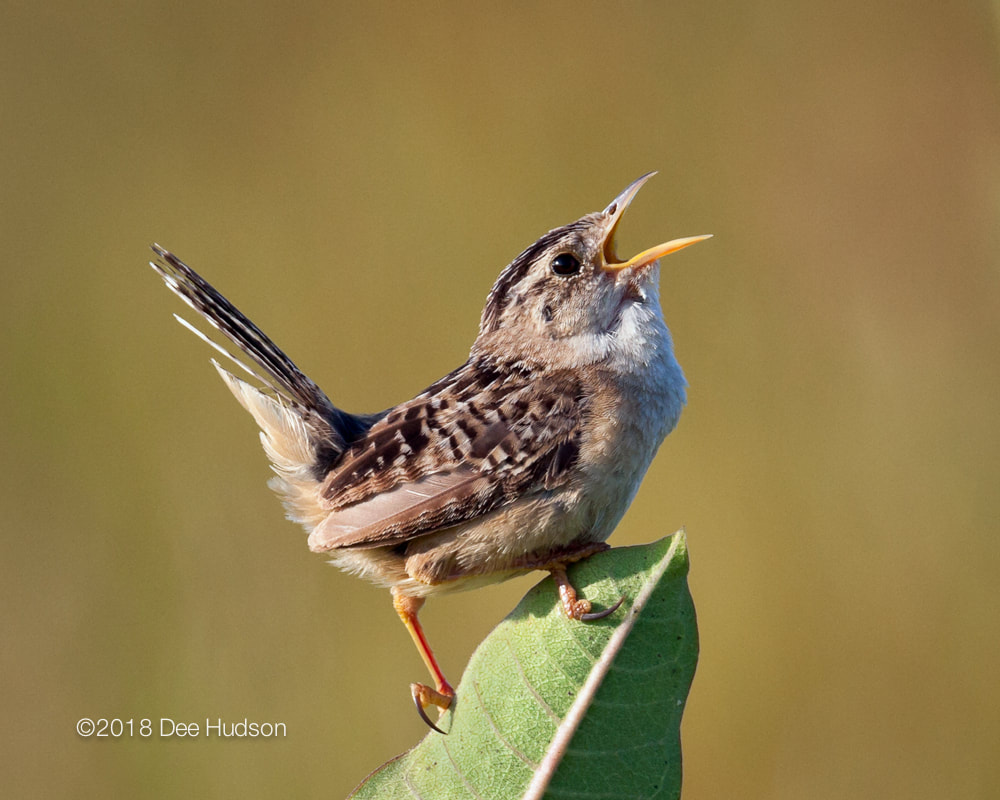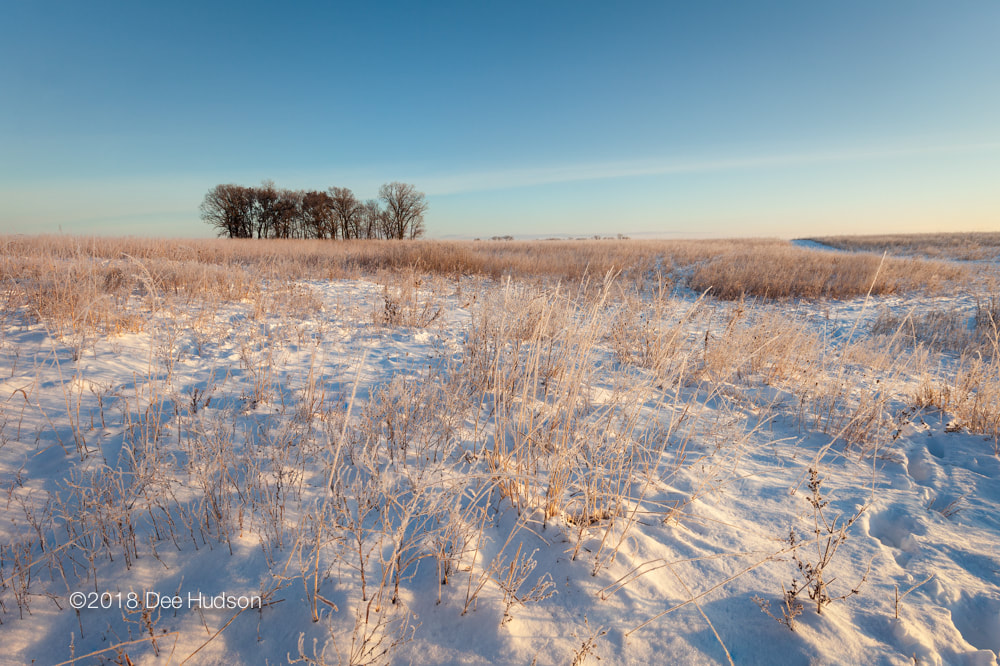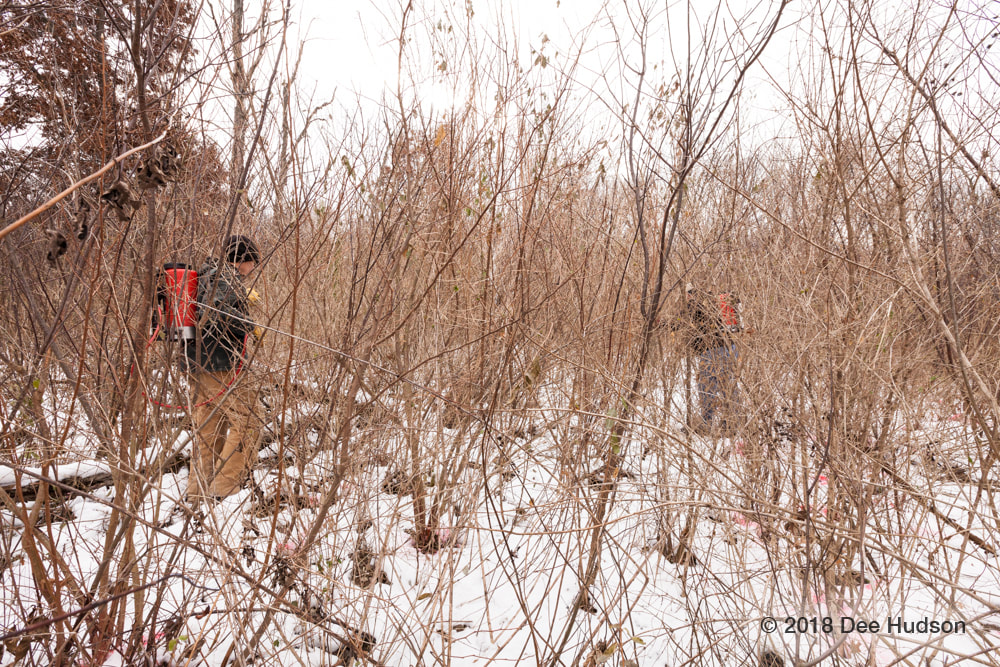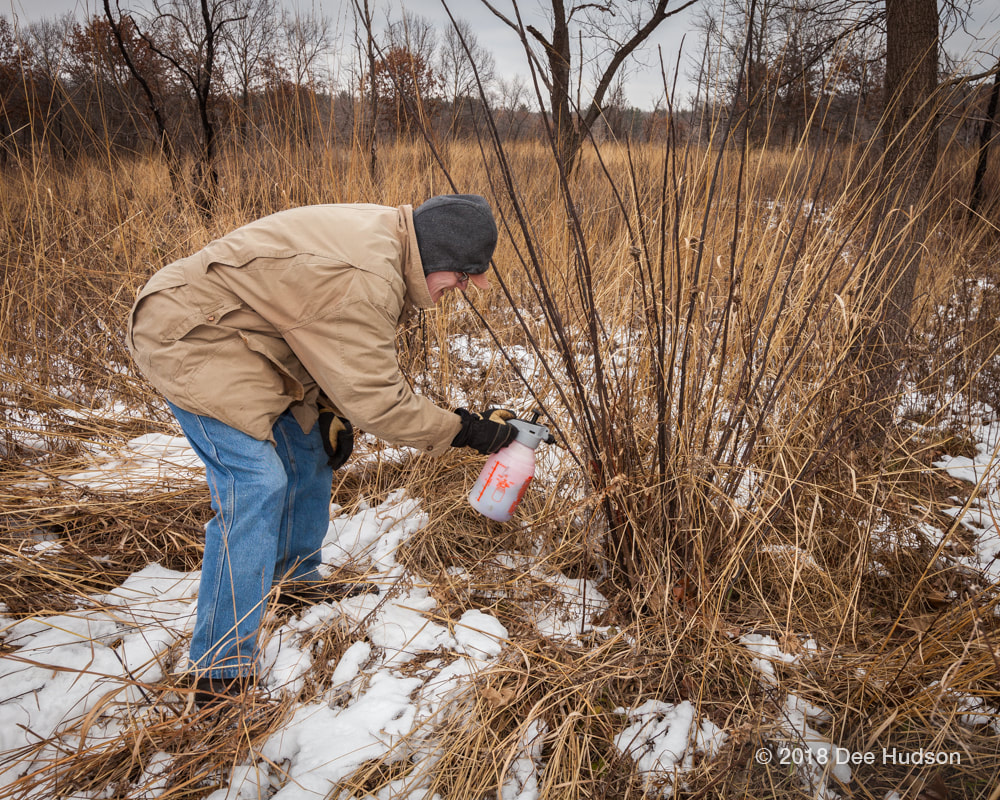|
By Dee Hudson What does a degraded landscape look like? Take a good look at the image below. The two volunteer stewards can barely walk through this dense thicket of invasive bushes. The sheer number of invasives that reside here have crowded out most other species, and as a result, have limited the possible diversity. In addition, when leafed out during the summer time, the bushes block the sunlight from reaching the ground and therefore discourage native species from growth. As Orland Prairie’s land steward, Mike Carr led the December 8 Saturday workday into this gnarly section in the attempt to eradicate the invasive brush. At the end of the day, each volunteer stewardship hour was carefully logged, because Illinois Clean Energy Community Foundation has approved this particular habitat as a grant project. When 400 volunteer hours of habitat care have been recorded, Illinois Clean Energy will present $4,000 to Friends of Nachusa Grasslands. What species are targeted for removal?
How is the brush eradicated? On this workday the volunteers treated the brush with basal bark applications. The treatment was applied to the base of the bush with either a backpack sprayer or a hand sprayer. What does a restored landscape look like? This landscape is also a part of the 23-acre grant project. The area once looked very degraded, but with basal bark treatments and prescribed fire, the brush understory was removed. Then prairie seeds were planted and the photo above shows the successful restored results. This area has been given new life and is on its way to recovery. Who restores these habitats? Anyone who wants to make a difference can help with restoration!
Next ICE Grant Workday Join fellow volunteers on December 22, 2018 for the next ICE Grant Saturday workday. Meet at Nachusa’s Headquarters Barn before 9 am and be ready to restore habitat. If you have any questions about the workdays, check the Friends of Nachusa Grasslands website. Let’s make a difference together! Connect with Illinois Clean Energy Community Foundation: @illnoiscleanenergycommunityfoundation
#CSgrantsIL #NAicecfdn By Dr. Elizabeth Bach, Ecosystem Restoration Scientist December 5 is World Soil Day, a time to recognize the vital role soils play in our ecosystems and health: growing food, filtering water, recycling air, mitigating climate change, and supporting more than 25% of all biodiversity! Soil is the foundation of prairie restoration at Nachusa Grasslands, the starting point of a prairie planting. There are many questions about how soils impact prairie restoration success and how prairie restoration affects soils. Today, we highlight a few of the soil-focused scientific studies that have been conducted at Nachusa Grasslands:
Question: Do communities of soil critters like earthworms, ants, ground beetles, centipedes, millipedes, and spiders change during prairie restoration? Answers: Prairie restoration increases the number, abundance, and mass of soil critters like earthworms, ants, centipedes, and spiders with time since planting. Interestingly, different prairie remnants, even within the Nachusa preserve, have very different communities of soil invertebrates, and it’s difficult to know what a typical remnant invertebrate community may look like. Wodika & Baer 2015. If we build it, will they colonize? A test of the field of dreams paradigm with soil macroinvertebrate communities. Applied Soil Ecology 91:80-89 Wodika et al. 2014. Colonization and recovery of invertebrate ecosystem engineers during prairie restoration. Restoration Ecology 22: 456-464 Ground beetles show a different pattern, with high numbers of species and abundance in young plantings. Although older plantings had lower species richness, the roles those species play in the ecosystem diverged, indicating that older plantings support stable, diverse beetle communities that fill multiple roles in the ecosystem (e.g. different sizes, active at different parts of the day/night, eating different things). Barber et al. 2017. Species and functional trait re-assembly of ground beetle communities in restored grasslands. Biodiversity and Conservation 26:3481-3498 Question: Do soil microbial communities change during prairie restoration? Answer: Older restorations at Nachusa host microbial communities that are distinct from younger plantings, and that more closely resemble remnant communities. A couple of the key bacterial groups distinctive of prairie remnants and older restorations are Verrucomicrobia and Acidobacteria. The next question is to learn more about what those bacteria do! Barber et al. 2017. Soil microbial community composition in tallgrass prairie restorations converge with remnants across a 27-year chronosequence. Environmental Microbiology 19: 3118-3131 Question: How does plant diversity impact ecosystem functions like soil carbon and nitrogen cycling? Answer: Nachusa’s high plant diversity restorations had more roots, more microbial mass (especially mycorrhizal fungi), more structured soil, and less “leaky” nitrogen compounds that can wind up in water ways compared with low plant diversity restorations in the same area. This is the first study to show that very high plant diversity restoration can lead to improved ecosystem functioning. Klopf et al. 2017. Restoration and management for plant diversity enhances the rate of belowground ecosystem recovery. Ecological Applications 27:355-362 |
Blog CoordinatorDee Hudson
I am a nature photographer, a freelance graphic designer, and steward at Nachusa's Thelma Carpenter Prairie. I have taken photos for Nachusa since 2012. EditorJames Higby
I have been a high school French teacher, registered piano technician, and librarian. In retirement I am a volunteer historian at Lee County Historical and Genealogical Society. Categories
All
Archives
January 2024
|
CONNECT WITH US |
|
























 RSS Feed
RSS Feed